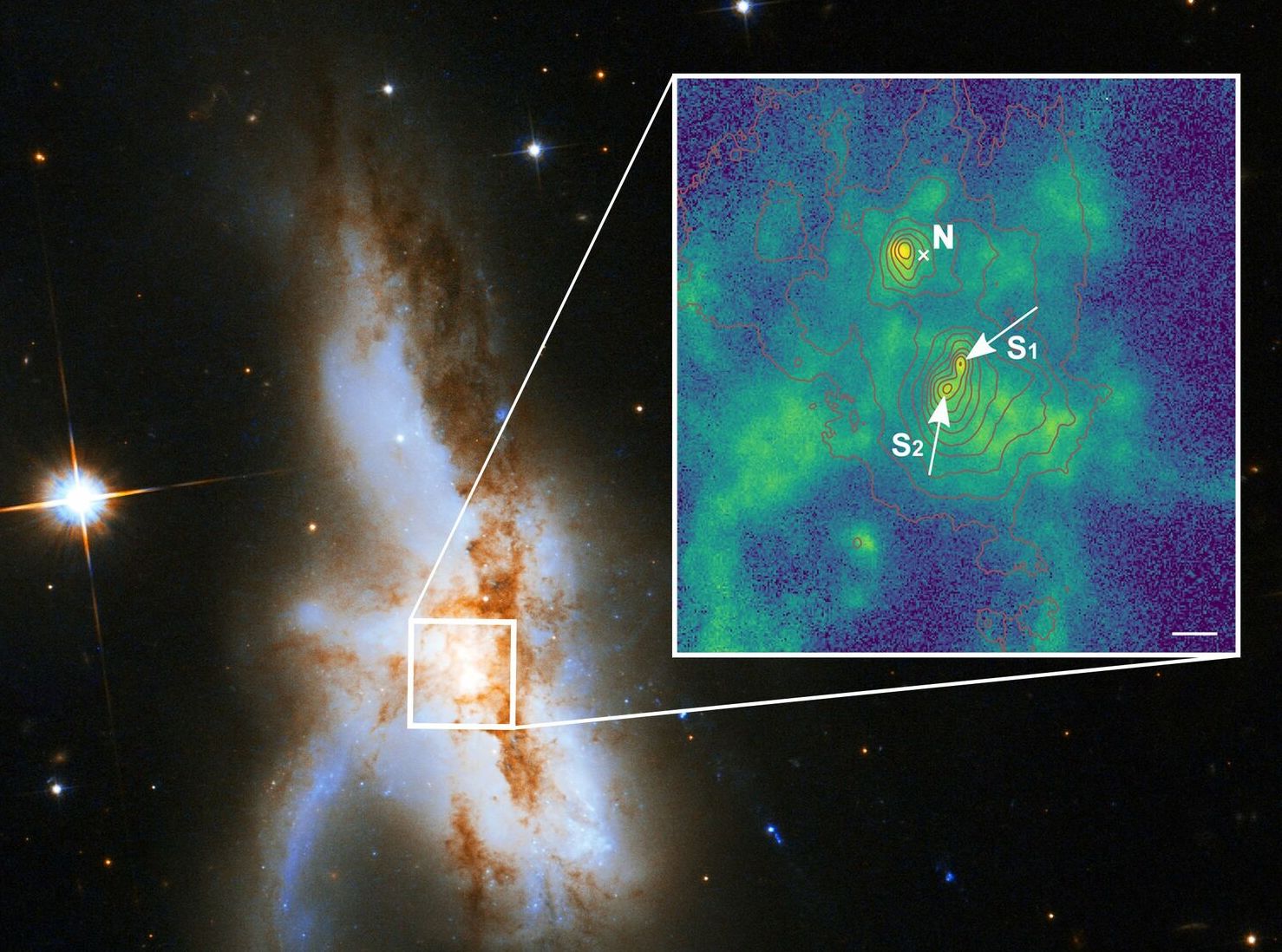天文学家在一个星系的中心发现了三个超大质量黑洞。
根据发表在杂志上的一项研究天文学和天体物理学黑洞位于星系的核心——NGC 6240——附近,离我们大约3亿光年。研究人员说,这一发现为宇宙中最大的星系是如何形成的提供了新的线索。
科学家认为宇宙中大多数大型星系——有数千亿颗恒星——在其中心都有一个超大质量黑洞。据信,这些黑洞的质量比太阳大几亿倍。
NGC 6240因其形状不规则而略有不同。科学家们一直认为它是由两个较小的星系碰撞形成的,因此在其中心包含两个黑洞。然而,最新的高分辨率观测揭示了一些意想不到的事情。
德国哥廷根大学该项研究的主要作者沃尔夫拉姆·科拉茨尼在一份声明中说:“通过我们以极高的空间分辨率进行的观察,我们能够表明,相互作用的星系NGC 6240在其中心并不像先前假设的那样拥有两个,而是三个超大质量黑洞。”。
天文学家说,这些超大质量黑洞的质量都比太阳大9000多万倍。它们位于一个不到3000光年的空间区域。
“到目前为止,宇宙中从未发现过如此集中的三个超大质量黑洞,”莱布尼茨天体物理研究所的另一项研究彼得·威尔巴赫在一份声明中说。"本案提供了三个星系及其中心黑洞同时合并的证据."

不规则星系NGC 6240。新的观察表明,它的核心不是两个而是三个超大质量黑洞。北部黑洞是活跃的,以前就知道了。放大后的新高空间分辨率图像显示,南部部分由两个超大质量黑洞(S1和S2)组成。)绿色表示被黑洞周围的辐射电离的气体分布。红线显示了星系星光的轮廓,白色条纹的长度相当于1000光年。美国航天局、欧空局、哈勃遗产科学研究所/光环-欧空局/哈勃合作研究所和埃文斯(弗吉尼亚大学、夏洛茨维尔/NRAO/石溪大学
这一点意义重大,因为到目前为止,天文学家还不能解释宇宙时代——大约140亿年——最大和最大质量的星系是如何通过正常的相互作用和合并过程形成的。
“然而,如果几个星系同时发生合并过程,那么带有中心超大质量黑洞的最大星系能够进化得更快,”威尔巴赫说。"我们的观察首次表明了这种情况."
超大质量黑洞是由智利的8米超大型望远镜(VLT)发现的,该望远镜由欧洲南方天文台操作。VLT是位于智利阿塔卡马沙漠的世界上最先进的可见光天文台。
VLT阵列由四个单元望远镜组成,主镜直径为8.2米。它们可以通过使用复杂的地下反射镜系统将探测到的光束结合在一起工作。这使得天文学家能够重建图像,其分辨率相当于区分月球远处汽车的两个前灯。
THREE SUPERMASSIVE BLACK HOLES DISCOVERED AT THE HEART OF ONE GALAXY
Astronomers have discovered three supermassive black holes at the heart of a single galaxy.
According to a study published in the journal Astronomy & Astrophysics, the black holes lie close to each other at the core of the galaxy known as NGC 6240—which is located around 300 million light-years away from us. This finding, the researchers say, casts new light on how the largest galaxies in the universe form.
Scientists think that most large galaxies in the universe—which have hundreds of billions of stars—host a supermassive black hole at their center. These black holes are believed to have masses hundreds of millions of times greater than that of the sun.
NGC 6240 is slightly unusual because of its irregular shape. Scientists long thought that it was formed by the collision of two smaller galaxies and, thus, contained two black holes at its center. However, the latest high-resolution observations revealed something unexpected.
"Through our observations with extremely high spatial resolution we were able to show that the interacting galaxy system NGC 6240 hosts not two—as previously assumed—but three supermassive black holes in its center," Wolfram Kollatschny, lead author of the study from the University of Göttingen, Germany, said in a statement.
The astronomers say that each of these supermassive black holes has a mass more than 90 million times greater than that of the sun. They are located in a region of space that is less than 3,000 light-years across.
"Up until now, such a concentration of three supermassive black holes had never been discovered in the universe," Peter Weilbacher, another of the study from the Leibniz Institute for Astrophysics Potsdam, said in a statement. "The present case provides evidence of a simultaneous merging process of three galaxies along with their central black holes."

The irregular galaxy NGC 6240. New observations show that it harbors not two but three supermassive black holes at its core. The northern black hole (N) is active and was known before. The zoomed-in new high-spatial resolution image shows that the southern component consists of two supermassive black holes (S1 and S2.) The green color indicates the distribution of gas ionized by radiation surrounding the black holes. The red lines show the contours of the starlight from the galaxy and the length of the white bar corresponds to 1,000 light-years.P WEILBACHER AIP), NASA, ESA, THE HUBBLE HERITAGE STSCI/AURA-ESA/HUBBLE COLLABORATION, AND A EVANS (UNIVERSITY OF VIRGINIA, CHARLOTTESVILLE/NRAO/STONY BROOK UNIVERSITY
This is significant because until now, astronomers have not been able to explain how the largest and most massive galaxies formed by normal interaction and merging processes over the age of the universe—approximately 14 billion years.
"If, however, simultaneous merging processes of several galaxies took place, then the largest galaxies with their central supermassive black holes were able to evolve much faster," Weilbacher said. "Our observations provide the first indication of this scenario."
The supermassive black holes were identified using the 8-meter Very Large Telescope (VLT) in Chile—which is operated by the European Southern Observatory. The VLT is the world's most advanced visible-light astronomical observatory located in Chile's Atacama Desert.
The VLT array consists of four Unit Telescopes with main mirrors measuring 8.2 meters in diameter. These can work together by combining the light beams they detect using a complex system of subterranean mirrors. This enables astronomers to reconstruct images with a resolution that is equivalent to distinguishing the two headlights of a car at the distance of the Moon.






